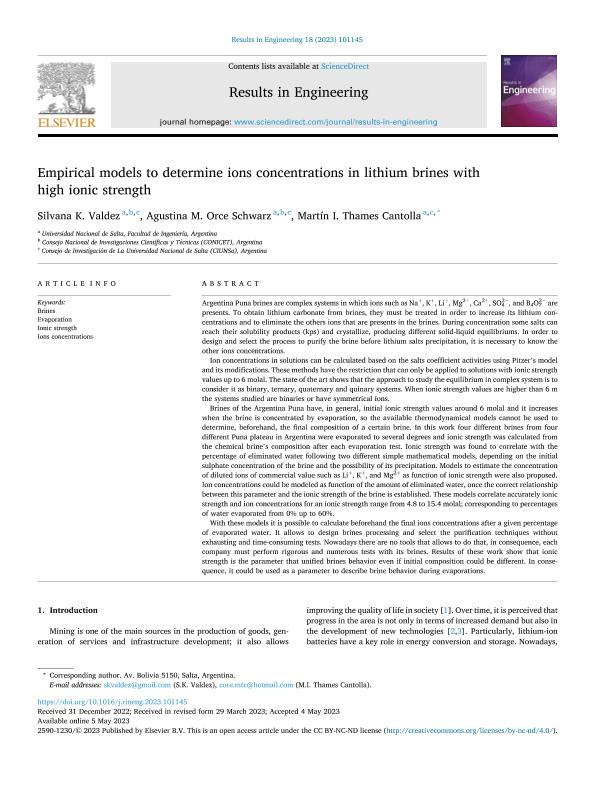Artículo
Empirical models to determine ions concentrations in lithium brines with high ionic strength
Fecha de publicación:
05/2023
Editorial:
Elsevier
Revista:
Results in Engineering
ISSN:
2590-1230
Idioma:
Inglés
Tipo de recurso:
Artículo publicado
Clasificación temática:
Resumen
Argentina Puna brines are complex systems in which ions such as Na+, K+, Li+, Mg2+, Ca2+, SO4 2− , and B4O7 2− are presents. To obtain lithium carbonate from brines, they must be treated in order to increase its lithium concentrations and to eliminate the others ions that are presents in the brines. During concentration some salts can reach their solubility products (kps) and crystallize, producing different solid-liquid equilibriums. In order to design and select the process to purify the brine before lithium salts precipitation, it is necessary to know the other ions concentrations. Ion concentrations in solutions can be calculated based on the salts coefficient activities using Pitzer’s model and its modifications. These methods have the restriction that can only be applied to solutions with ionic strength values up to 6 molal. The state of the art shows that the approach to study the equilibrium in complex system is to consider it as binary, ternary, quaternary and quinary systems. When ionic strength values are higher than 6 m the systems studied are binaries or have symmetrical ions. Brines of the Argentina Puna have, in general, initial ionic strength values around 6 molal and it increases when the brine is concentrated by evaporation, so the available thermodynamical models cannot be used to determine, beforehand, the final composition of a certain brine. In this work four different brines from four different Puna plateau in Argentina were evaporated to several degrees and ionic strength was calculated from the chemical brine’s composition after each evaporation test. Ionic strength was found to correlate with the percentage of eliminated water following two different simple mathematical models, depending on the initial sulphate concentration of the brine and the possibility of its precipitation. Models to estimate the concentration of diluted ions of commercial value such as Li+, K+, and Mg2+ as function of ionic strength were also proposed. Ion concentrations could be modeled as function of the amount of eliminated water, once the correct relationship between this parameter and the ionic strength of the brine is established. These models correlate accurately ionic strength and ion concentrations for an ionic strength range from 4.8 to 15.4 molal; corresponding to percentages of water evaporated from 0% up to 60%. With these models it is possible to calculate beforehand the final ions concentrations after a given percentage of evaporated water. It allows to design brines processing and select the purification techniques without exhausting and time-consuming tests. Nowadays there are no tools that allows to do that, in consequence, each company must perform rigorous and numerous tests with its brines. Results of these work show that ionic strength is the parameter that unified brines behavior even if initial composition could be different. In consequence, it could be used as a parameter to describe brine behavior during evaporations.
Palabras clave:
BRINES
,
EVAPORATION
,
IONIC STRENGTH
,
IONS CONCENTRATIONS
Archivos asociados
Licencia
Identificadores
Colecciones
Articulos(INIQUI)
Articulos de INST.DE INVEST.PARA LA INDUSTRIA QUIMICA (I)
Articulos de INST.DE INVEST.PARA LA INDUSTRIA QUIMICA (I)
Citación
Valdez, Silvana Karina; Orce Schwarz, Agustina María; Thames Cantolla, Martin Ignacio; Empirical models to determine ions concentrations in lithium brines with high ionic strength; Elsevier; Results in Engineering; 18; 5-2023; 1-10
Compartir
Altmétricas




